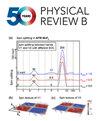在具有强拉什巴效应的磁性半导体磁畴壁上出现的电子态
IF 3.7
2区 物理与天体物理
Q1 Physics and Astronomy
引用次数: 0
摘要
在本文中,我们探讨了具有强 Rashba 自旋轨道耦合的磁性半导体的电子特性,同时考虑了样品表面存在的畴墙。我们考虑了分隔面内磁化和面外磁化的反相畴壁以及非共轭畴壁。首先,我们提出了模型,并在分析论证的支持下揭示了这一现象的一般物理图景。此外,我们还进行了全面的紧约束数值计算,以深刻理解我们的发现。我们证明,分隔任何极化方向的畴的畴壁都承载着一个束缚态。更有趣的是,我们预测这些畴壁中的任何一个都能诱导出一维共振态。态的表面能谱和自旋极化对相邻畴的磁化方向高度敏感。共振态的光谱拓宽和空间定位在很大程度上取决于拉什巴分裂和交换分裂之间的关系。我们的估计结果表明,与长寿命共振态相关的手性传导通道可以沿着磁畴壁出现,并且可以在掺杂过渡金属原子的 BiTeI 表面进行实验。本文章由计算机程序翻译,如有差异,请以英文原文为准。
Electron states emerging at magnetic domain walls of magnetic semiconductors with strong Rashba effect
In the present article, we explore the electron properties of magnetic semiconductors with strong Rashba spin-orbit coupling, taking into account the presence of domain walls at the sample surface. We consider antiphase domain walls separating domains with both in-plane and out-of-plane magnetization as well as noncollinear domain walls. First, we propose the model and unveil the general physical picture of the phenomenon supported by analytical arguments. Further, we perform comprehensive tight-binding numerical calculations to provide a profound understanding of our findings. A domain wall separating domains with any polarization direction is demonstrated to host a bound state. What is more interesting is that we predict that either of these domain walls also induces a one-dimensional resonant state. The surface energy spectrum and spin polarization of the states are highly sensitive to the magnetization orientation in the adjacent domains. The spectral broadening and the spatial localization of the resonant state depend significantly on a relation between the Rashba splitting and the exchange one. Our estimation shows that chiral conducting channels associated with the long-lived resonant states can emerge along the magnetic domain walls and can be accessed experimentally at the surface of BiTeI doped with transition metal atoms.
求助全文
通过发布文献求助,成功后即可免费获取论文全文。
去求助
来源期刊

Physical Review B
物理-物理:凝聚态物理
CiteScore
6.70
自引率
32.40%
发文量
0
审稿时长
3.0 months
期刊介绍:
Physical Review B (PRB) is the world’s largest dedicated physics journal, publishing approximately 100 new, high-quality papers each week. The most highly cited journal in condensed matter physics, PRB provides outstanding depth and breadth of coverage, combined with unrivaled context and background for ongoing research by scientists worldwide.
PRB covers the full range of condensed matter, materials physics, and related subfields, including:
-Structure and phase transitions
-Ferroelectrics and multiferroics
-Disordered systems and alloys
-Magnetism
-Superconductivity
-Electronic structure, photonics, and metamaterials
-Semiconductors and mesoscopic systems
-Surfaces, nanoscience, and two-dimensional materials
-Topological states of matter
 求助内容:
求助内容: 应助结果提醒方式:
应助结果提醒方式:


